BBEK1103 Principles of Microeconomics: Market Structure Analysis
VerifiedAdded on 2023/01/20
|15
|3814
|24
Report
AI Summary
This report delves into the theory of market structures, a core concept in microeconomics. It provides a comprehensive overview of different market structures, including perfect competition, oligopoly, monopolistic competition, and monopoly, detailing their characteristics, mechanisms, and equilibrium conditions in both the short and long run. The report uses Tenaga Nasional Berhad (TNB), Malaysia's largest electricity provider, as a case study to illustrate the practical application of these concepts. It examines how TNB fits the monopolistic market structure, analyzing its behavior in the short and long run, and explaining how it achieves equilibrium under these conditions. The report also includes discussions on market dynamics, profitability, and the influence of factors such as product homogeneity and barriers to entry and exit on market structures. The report aims to provide a thorough understanding of market structures and their implications for businesses operating within them.
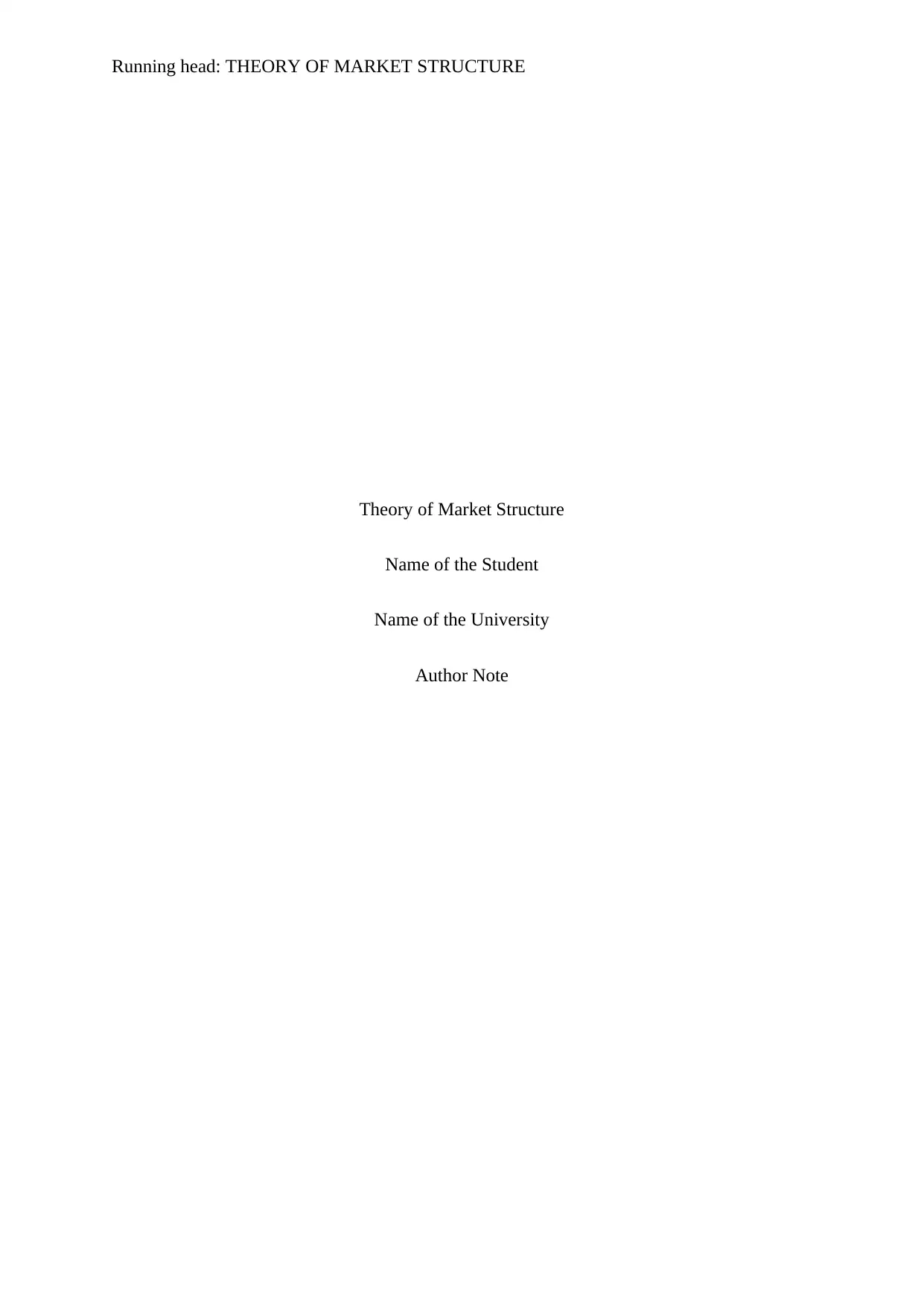
Running head: THEORY OF MARKET STRUCTURE
Theory of Market Structure
Name of the Student
Name of the University
Author Note
Theory of Market Structure
Name of the Student
Name of the University
Author Note
Paraphrase This Document
Need a fresh take? Get an instant paraphrase of this document with our AI Paraphraser
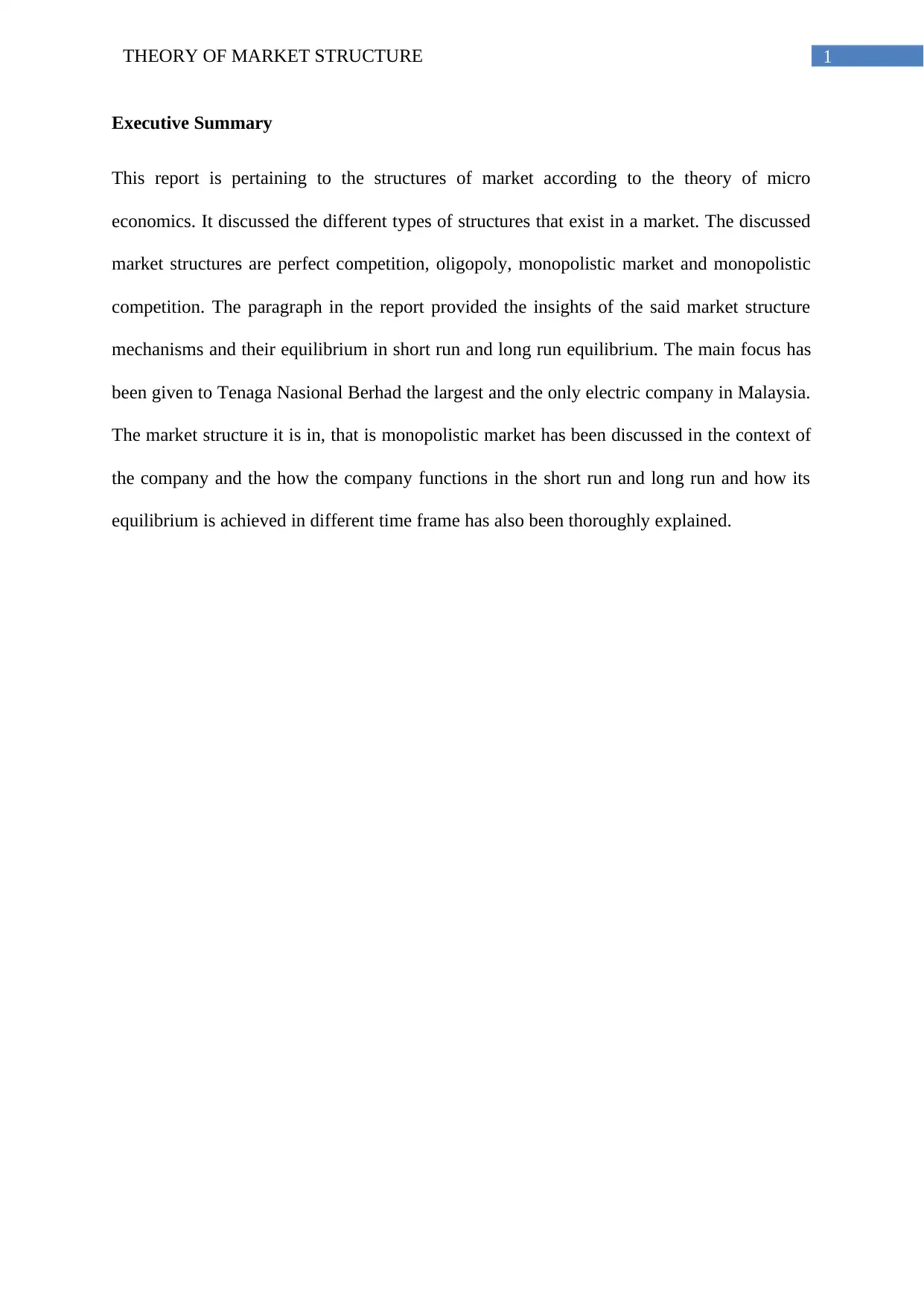
1THEORY OF MARKET STRUCTURE
Executive Summary
This report is pertaining to the structures of market according to the theory of micro
economics. It discussed the different types of structures that exist in a market. The discussed
market structures are perfect competition, oligopoly, monopolistic market and monopolistic
competition. The paragraph in the report provided the insights of the said market structure
mechanisms and their equilibrium in short run and long run equilibrium. The main focus has
been given to Tenaga Nasional Berhad the largest and the only electric company in Malaysia.
The market structure it is in, that is monopolistic market has been discussed in the context of
the company and the how the company functions in the short run and long run and how its
equilibrium is achieved in different time frame has also been thoroughly explained.
Executive Summary
This report is pertaining to the structures of market according to the theory of micro
economics. It discussed the different types of structures that exist in a market. The discussed
market structures are perfect competition, oligopoly, monopolistic market and monopolistic
competition. The paragraph in the report provided the insights of the said market structure
mechanisms and their equilibrium in short run and long run equilibrium. The main focus has
been given to Tenaga Nasional Berhad the largest and the only electric company in Malaysia.
The market structure it is in, that is monopolistic market has been discussed in the context of
the company and the how the company functions in the short run and long run and how its
equilibrium is achieved in different time frame has also been thoroughly explained.
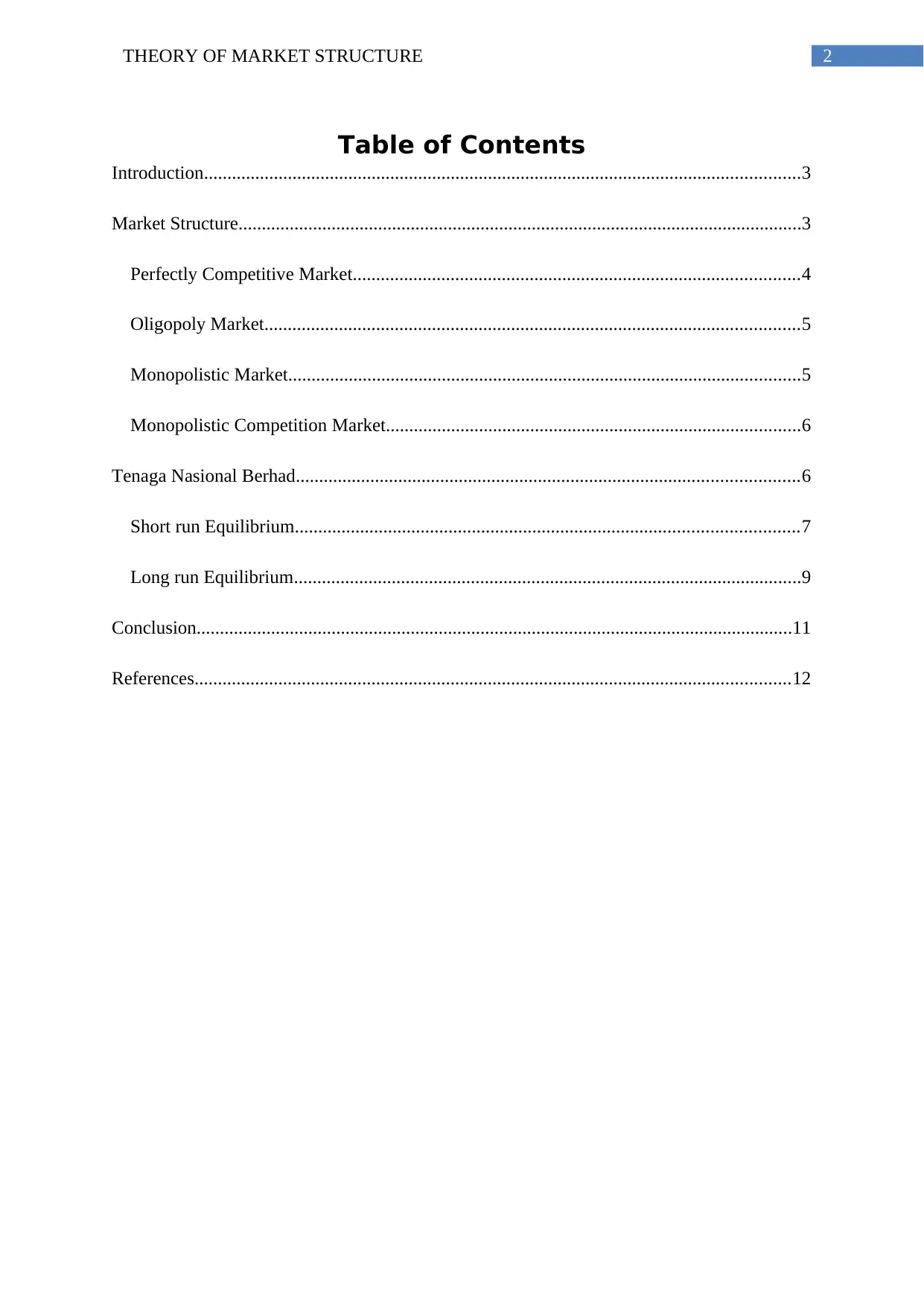
2THEORY OF MARKET STRUCTURE
Table of Contents
Introduction................................................................................................................................3
Market Structure.........................................................................................................................3
Perfectly Competitive Market................................................................................................4
Oligopoly Market...................................................................................................................5
Monopolistic Market..............................................................................................................5
Monopolistic Competition Market.........................................................................................6
Tenaga Nasional Berhad............................................................................................................6
Short run Equilibrium............................................................................................................7
Long run Equilibrium.............................................................................................................9
Conclusion................................................................................................................................11
References................................................................................................................................12
Table of Contents
Introduction................................................................................................................................3
Market Structure.........................................................................................................................3
Perfectly Competitive Market................................................................................................4
Oligopoly Market...................................................................................................................5
Monopolistic Market..............................................................................................................5
Monopolistic Competition Market.........................................................................................6
Tenaga Nasional Berhad............................................................................................................6
Short run Equilibrium............................................................................................................7
Long run Equilibrium.............................................................................................................9
Conclusion................................................................................................................................11
References................................................................................................................................12
⊘ This is a preview!⊘
Do you want full access?
Subscribe today to unlock all pages.

Trusted by 1+ million students worldwide

3THEORY OF MARKET STRUCTURE
Introduction
Theory of microeconomics explains different types of market structure and
categorizes it into three major structures that are perfectly competitive market, monopoly
market and oligopoly market. The profitability, number of firms, type of product that means
homogeneous or heterogeneous and its uniqueness decides the structure of the market. Hence,
the report discusses characteristics of all the three market structures and explains the
equilibrium conditions and profitability terms. In order to get a broader understanding of the
theory a Malaysian company is considered in this report. The name of the company is Tenaga
Nasional Berhad, which is an electricity company in Malaysia. In the following sections, the
description of the company will be given and the type of market structure it fits is explained
along. The reasons behind the market structure it is in, is discussed by pointing out its
influence over the market and the product it offers. The possible situations that gave rise to
the market structure of Tenaga Nasional Berhad have been explained. The discussion has also
been extended to the short run and long run equilibrium of the company and the process how
the company achieves such equilibrium. Hence, the aim of the report is to focus on all the
existing structure of the market with all and apply the understanding to find the market
structure of the selected electrical company and discuss its market structure in detail with its
equilibrium conditions and sustainability.
Market Structure
The different firms with different products sell their product in a market. However, as
far as the products offered by the firms are completely different from each other such that
they do not even target same customer base then there will no competition among the firms.
Now, if there are numerous firms offering similar products targeting same customer base then
the firms are considered to be operating in perfectly competitive market (Pindyck &
Introduction
Theory of microeconomics explains different types of market structure and
categorizes it into three major structures that are perfectly competitive market, monopoly
market and oligopoly market. The profitability, number of firms, type of product that means
homogeneous or heterogeneous and its uniqueness decides the structure of the market. Hence,
the report discusses characteristics of all the three market structures and explains the
equilibrium conditions and profitability terms. In order to get a broader understanding of the
theory a Malaysian company is considered in this report. The name of the company is Tenaga
Nasional Berhad, which is an electricity company in Malaysia. In the following sections, the
description of the company will be given and the type of market structure it fits is explained
along. The reasons behind the market structure it is in, is discussed by pointing out its
influence over the market and the product it offers. The possible situations that gave rise to
the market structure of Tenaga Nasional Berhad have been explained. The discussion has also
been extended to the short run and long run equilibrium of the company and the process how
the company achieves such equilibrium. Hence, the aim of the report is to focus on all the
existing structure of the market with all and apply the understanding to find the market
structure of the selected electrical company and discuss its market structure in detail with its
equilibrium conditions and sustainability.
Market Structure
The different firms with different products sell their product in a market. However, as
far as the products offered by the firms are completely different from each other such that
they do not even target same customer base then there will no competition among the firms.
Now, if there are numerous firms offering similar products targeting same customer base then
the firms are considered to be operating in perfectly competitive market (Pindyck &
Paraphrase This Document
Need a fresh take? Get an instant paraphrase of this document with our AI Paraphraser
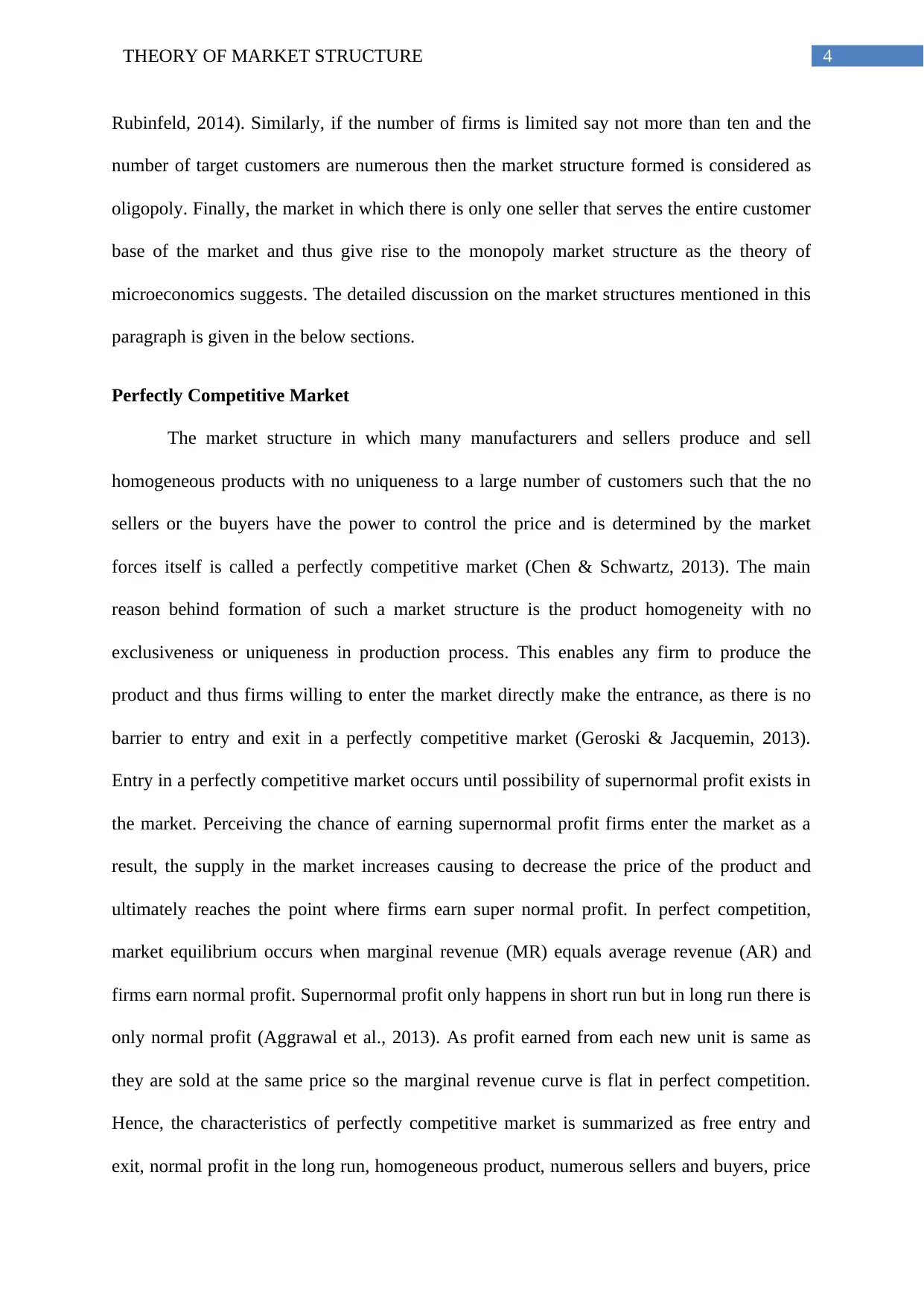
4THEORY OF MARKET STRUCTURE
Rubinfeld, 2014). Similarly, if the number of firms is limited say not more than ten and the
number of target customers are numerous then the market structure formed is considered as
oligopoly. Finally, the market in which there is only one seller that serves the entire customer
base of the market and thus give rise to the monopoly market structure as the theory of
microeconomics suggests. The detailed discussion on the market structures mentioned in this
paragraph is given in the below sections.
Perfectly Competitive Market
The market structure in which many manufacturers and sellers produce and sell
homogeneous products with no uniqueness to a large number of customers such that the no
sellers or the buyers have the power to control the price and is determined by the market
forces itself is called a perfectly competitive market (Chen & Schwartz, 2013). The main
reason behind formation of such a market structure is the product homogeneity with no
exclusiveness or uniqueness in production process. This enables any firm to produce the
product and thus firms willing to enter the market directly make the entrance, as there is no
barrier to entry and exit in a perfectly competitive market (Geroski & Jacquemin, 2013).
Entry in a perfectly competitive market occurs until possibility of supernormal profit exists in
the market. Perceiving the chance of earning supernormal profit firms enter the market as a
result, the supply in the market increases causing to decrease the price of the product and
ultimately reaches the point where firms earn super normal profit. In perfect competition,
market equilibrium occurs when marginal revenue (MR) equals average revenue (AR) and
firms earn normal profit. Supernormal profit only happens in short run but in long run there is
only normal profit (Aggrawal et al., 2013). As profit earned from each new unit is same as
they are sold at the same price so the marginal revenue curve is flat in perfect competition.
Hence, the characteristics of perfectly competitive market is summarized as free entry and
exit, normal profit in the long run, homogeneous product, numerous sellers and buyers, price
Rubinfeld, 2014). Similarly, if the number of firms is limited say not more than ten and the
number of target customers are numerous then the market structure formed is considered as
oligopoly. Finally, the market in which there is only one seller that serves the entire customer
base of the market and thus give rise to the monopoly market structure as the theory of
microeconomics suggests. The detailed discussion on the market structures mentioned in this
paragraph is given in the below sections.
Perfectly Competitive Market
The market structure in which many manufacturers and sellers produce and sell
homogeneous products with no uniqueness to a large number of customers such that the no
sellers or the buyers have the power to control the price and is determined by the market
forces itself is called a perfectly competitive market (Chen & Schwartz, 2013). The main
reason behind formation of such a market structure is the product homogeneity with no
exclusiveness or uniqueness in production process. This enables any firm to produce the
product and thus firms willing to enter the market directly make the entrance, as there is no
barrier to entry and exit in a perfectly competitive market (Geroski & Jacquemin, 2013).
Entry in a perfectly competitive market occurs until possibility of supernormal profit exists in
the market. Perceiving the chance of earning supernormal profit firms enter the market as a
result, the supply in the market increases causing to decrease the price of the product and
ultimately reaches the point where firms earn super normal profit. In perfect competition,
market equilibrium occurs when marginal revenue (MR) equals average revenue (AR) and
firms earn normal profit. Supernormal profit only happens in short run but in long run there is
only normal profit (Aggrawal et al., 2013). As profit earned from each new unit is same as
they are sold at the same price so the marginal revenue curve is flat in perfect competition.
Hence, the characteristics of perfectly competitive market is summarized as free entry and
exit, normal profit in the long run, homogeneous product, numerous sellers and buyers, price
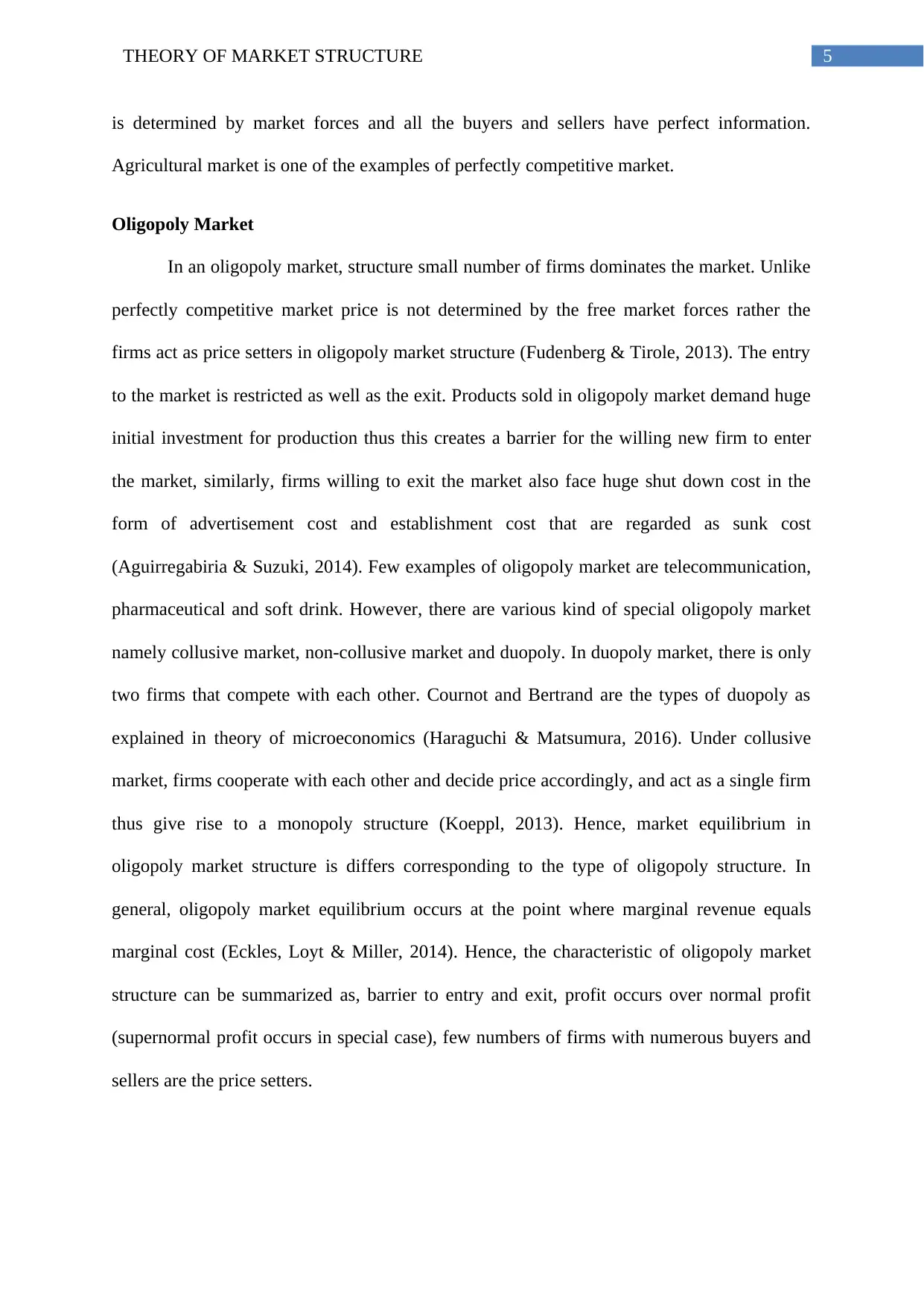
5THEORY OF MARKET STRUCTURE
is determined by market forces and all the buyers and sellers have perfect information.
Agricultural market is one of the examples of perfectly competitive market.
Oligopoly Market
In an oligopoly market, structure small number of firms dominates the market. Unlike
perfectly competitive market price is not determined by the free market forces rather the
firms act as price setters in oligopoly market structure (Fudenberg & Tirole, 2013). The entry
to the market is restricted as well as the exit. Products sold in oligopoly market demand huge
initial investment for production thus this creates a barrier for the willing new firm to enter
the market, similarly, firms willing to exit the market also face huge shut down cost in the
form of advertisement cost and establishment cost that are regarded as sunk cost
(Aguirregabiria & Suzuki, 2014). Few examples of oligopoly market are telecommunication,
pharmaceutical and soft drink. However, there are various kind of special oligopoly market
namely collusive market, non-collusive market and duopoly. In duopoly market, there is only
two firms that compete with each other. Cournot and Bertrand are the types of duopoly as
explained in theory of microeconomics (Haraguchi & Matsumura, 2016). Under collusive
market, firms cooperate with each other and decide price accordingly, and act as a single firm
thus give rise to a monopoly structure (Koeppl, 2013). Hence, market equilibrium in
oligopoly market structure is differs corresponding to the type of oligopoly structure. In
general, oligopoly market equilibrium occurs at the point where marginal revenue equals
marginal cost (Eckles, Loyt & Miller, 2014). Hence, the characteristic of oligopoly market
structure can be summarized as, barrier to entry and exit, profit occurs over normal profit
(supernormal profit occurs in special case), few numbers of firms with numerous buyers and
sellers are the price setters.
is determined by market forces and all the buyers and sellers have perfect information.
Agricultural market is one of the examples of perfectly competitive market.
Oligopoly Market
In an oligopoly market, structure small number of firms dominates the market. Unlike
perfectly competitive market price is not determined by the free market forces rather the
firms act as price setters in oligopoly market structure (Fudenberg & Tirole, 2013). The entry
to the market is restricted as well as the exit. Products sold in oligopoly market demand huge
initial investment for production thus this creates a barrier for the willing new firm to enter
the market, similarly, firms willing to exit the market also face huge shut down cost in the
form of advertisement cost and establishment cost that are regarded as sunk cost
(Aguirregabiria & Suzuki, 2014). Few examples of oligopoly market are telecommunication,
pharmaceutical and soft drink. However, there are various kind of special oligopoly market
namely collusive market, non-collusive market and duopoly. In duopoly market, there is only
two firms that compete with each other. Cournot and Bertrand are the types of duopoly as
explained in theory of microeconomics (Haraguchi & Matsumura, 2016). Under collusive
market, firms cooperate with each other and decide price accordingly, and act as a single firm
thus give rise to a monopoly structure (Koeppl, 2013). Hence, market equilibrium in
oligopoly market structure is differs corresponding to the type of oligopoly structure. In
general, oligopoly market equilibrium occurs at the point where marginal revenue equals
marginal cost (Eckles, Loyt & Miller, 2014). Hence, the characteristic of oligopoly market
structure can be summarized as, barrier to entry and exit, profit occurs over normal profit
(supernormal profit occurs in special case), few numbers of firms with numerous buyers and
sellers are the price setters.
⊘ This is a preview!⊘
Do you want full access?
Subscribe today to unlock all pages.

Trusted by 1+ million students worldwide
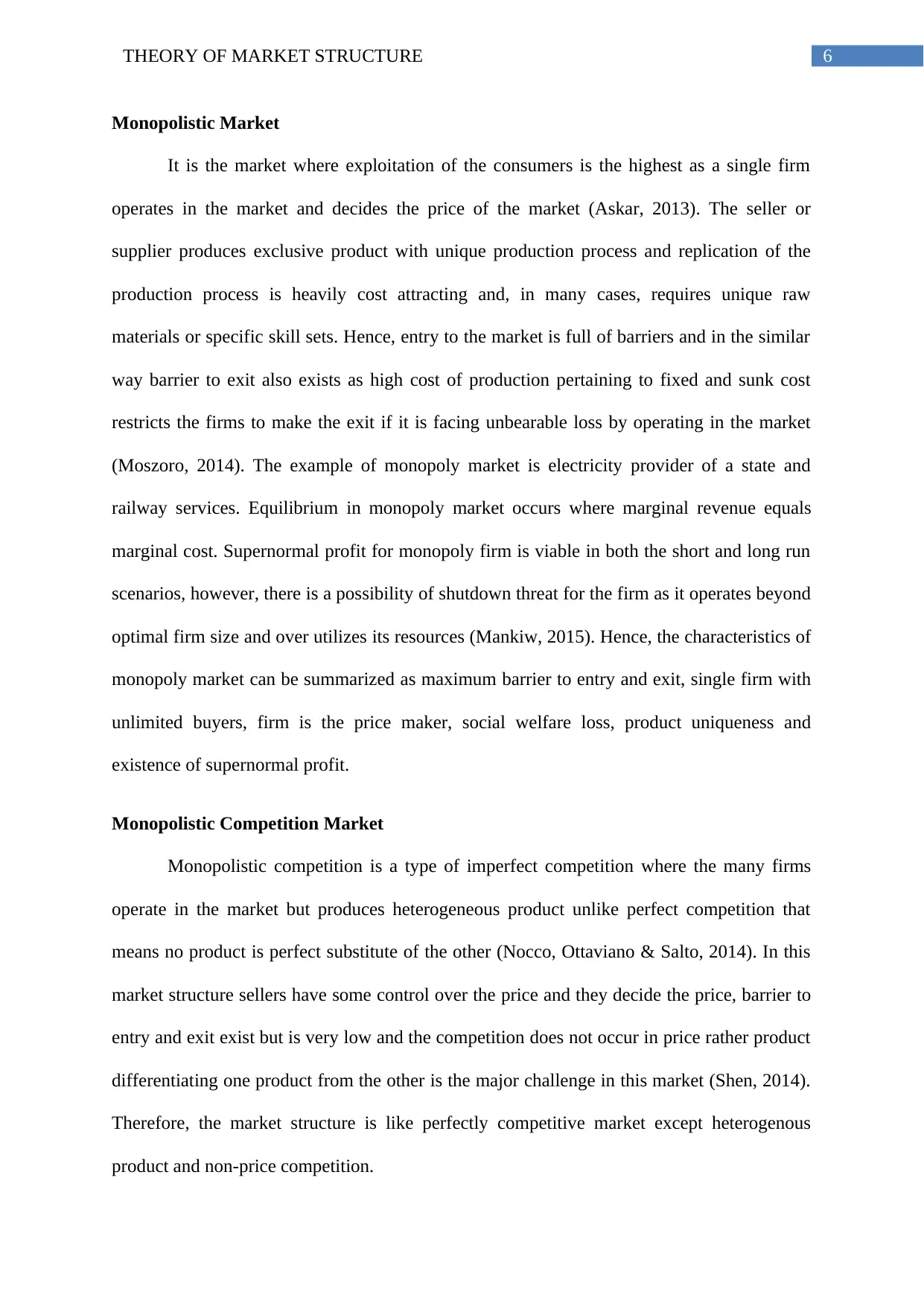
6THEORY OF MARKET STRUCTURE
Monopolistic Market
It is the market where exploitation of the consumers is the highest as a single firm
operates in the market and decides the price of the market (Askar, 2013). The seller or
supplier produces exclusive product with unique production process and replication of the
production process is heavily cost attracting and, in many cases, requires unique raw
materials or specific skill sets. Hence, entry to the market is full of barriers and in the similar
way barrier to exit also exists as high cost of production pertaining to fixed and sunk cost
restricts the firms to make the exit if it is facing unbearable loss by operating in the market
(Moszoro, 2014). The example of monopoly market is electricity provider of a state and
railway services. Equilibrium in monopoly market occurs where marginal revenue equals
marginal cost. Supernormal profit for monopoly firm is viable in both the short and long run
scenarios, however, there is a possibility of shutdown threat for the firm as it operates beyond
optimal firm size and over utilizes its resources (Mankiw, 2015). Hence, the characteristics of
monopoly market can be summarized as maximum barrier to entry and exit, single firm with
unlimited buyers, firm is the price maker, social welfare loss, product uniqueness and
existence of supernormal profit.
Monopolistic Competition Market
Monopolistic competition is a type of imperfect competition where the many firms
operate in the market but produces heterogeneous product unlike perfect competition that
means no product is perfect substitute of the other (Nocco, Ottaviano & Salto, 2014). In this
market structure sellers have some control over the price and they decide the price, barrier to
entry and exit exist but is very low and the competition does not occur in price rather product
differentiating one product from the other is the major challenge in this market (Shen, 2014).
Therefore, the market structure is like perfectly competitive market except heterogenous
product and non-price competition.
Monopolistic Market
It is the market where exploitation of the consumers is the highest as a single firm
operates in the market and decides the price of the market (Askar, 2013). The seller or
supplier produces exclusive product with unique production process and replication of the
production process is heavily cost attracting and, in many cases, requires unique raw
materials or specific skill sets. Hence, entry to the market is full of barriers and in the similar
way barrier to exit also exists as high cost of production pertaining to fixed and sunk cost
restricts the firms to make the exit if it is facing unbearable loss by operating in the market
(Moszoro, 2014). The example of monopoly market is electricity provider of a state and
railway services. Equilibrium in monopoly market occurs where marginal revenue equals
marginal cost. Supernormal profit for monopoly firm is viable in both the short and long run
scenarios, however, there is a possibility of shutdown threat for the firm as it operates beyond
optimal firm size and over utilizes its resources (Mankiw, 2015). Hence, the characteristics of
monopoly market can be summarized as maximum barrier to entry and exit, single firm with
unlimited buyers, firm is the price maker, social welfare loss, product uniqueness and
existence of supernormal profit.
Monopolistic Competition Market
Monopolistic competition is a type of imperfect competition where the many firms
operate in the market but produces heterogeneous product unlike perfect competition that
means no product is perfect substitute of the other (Nocco, Ottaviano & Salto, 2014). In this
market structure sellers have some control over the price and they decide the price, barrier to
entry and exit exist but is very low and the competition does not occur in price rather product
differentiating one product from the other is the major challenge in this market (Shen, 2014).
Therefore, the market structure is like perfectly competitive market except heterogenous
product and non-price competition.
Paraphrase This Document
Need a fresh take? Get an instant paraphrase of this document with our AI Paraphraser
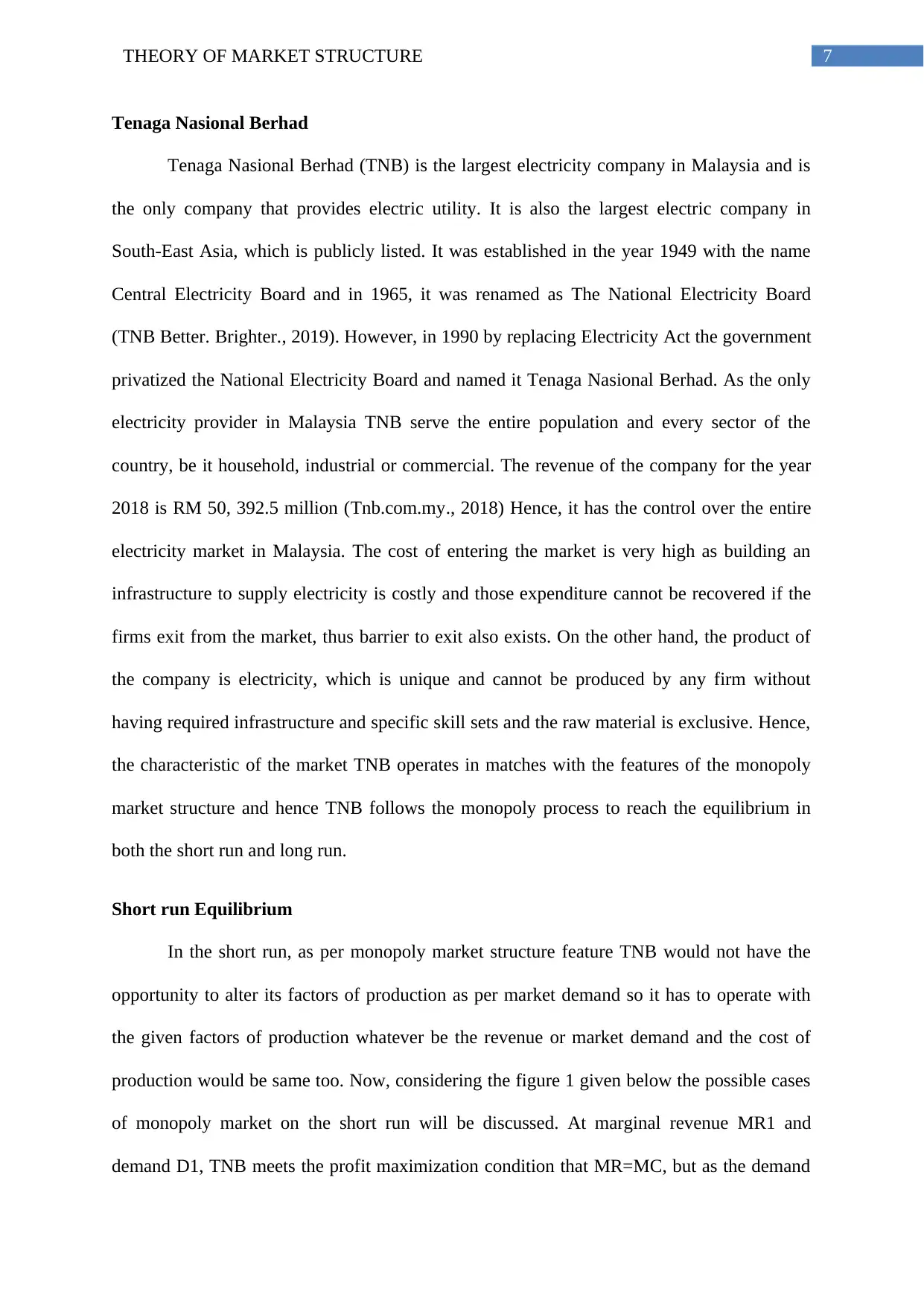
7THEORY OF MARKET STRUCTURE
Tenaga Nasional Berhad
Tenaga Nasional Berhad (TNB) is the largest electricity company in Malaysia and is
the only company that provides electric utility. It is also the largest electric company in
South-East Asia, which is publicly listed. It was established in the year 1949 with the name
Central Electricity Board and in 1965, it was renamed as The National Electricity Board
(TNB Better. Brighter., 2019). However, in 1990 by replacing Electricity Act the government
privatized the National Electricity Board and named it Tenaga Nasional Berhad. As the only
electricity provider in Malaysia TNB serve the entire population and every sector of the
country, be it household, industrial or commercial. The revenue of the company for the year
2018 is RM 50, 392.5 million (Tnb.com.my., 2018) Hence, it has the control over the entire
electricity market in Malaysia. The cost of entering the market is very high as building an
infrastructure to supply electricity is costly and those expenditure cannot be recovered if the
firms exit from the market, thus barrier to exit also exists. On the other hand, the product of
the company is electricity, which is unique and cannot be produced by any firm without
having required infrastructure and specific skill sets and the raw material is exclusive. Hence,
the characteristic of the market TNB operates in matches with the features of the monopoly
market structure and hence TNB follows the monopoly process to reach the equilibrium in
both the short run and long run.
Short run Equilibrium
In the short run, as per monopoly market structure feature TNB would not have the
opportunity to alter its factors of production as per market demand so it has to operate with
the given factors of production whatever be the revenue or market demand and the cost of
production would be same too. Now, considering the figure 1 given below the possible cases
of monopoly market on the short run will be discussed. At marginal revenue MR1 and
demand D1, TNB meets the profit maximization condition that MR=MC, but as the demand
Tenaga Nasional Berhad
Tenaga Nasional Berhad (TNB) is the largest electricity company in Malaysia and is
the only company that provides electric utility. It is also the largest electric company in
South-East Asia, which is publicly listed. It was established in the year 1949 with the name
Central Electricity Board and in 1965, it was renamed as The National Electricity Board
(TNB Better. Brighter., 2019). However, in 1990 by replacing Electricity Act the government
privatized the National Electricity Board and named it Tenaga Nasional Berhad. As the only
electricity provider in Malaysia TNB serve the entire population and every sector of the
country, be it household, industrial or commercial. The revenue of the company for the year
2018 is RM 50, 392.5 million (Tnb.com.my., 2018) Hence, it has the control over the entire
electricity market in Malaysia. The cost of entering the market is very high as building an
infrastructure to supply electricity is costly and those expenditure cannot be recovered if the
firms exit from the market, thus barrier to exit also exists. On the other hand, the product of
the company is electricity, which is unique and cannot be produced by any firm without
having required infrastructure and specific skill sets and the raw material is exclusive. Hence,
the characteristic of the market TNB operates in matches with the features of the monopoly
market structure and hence TNB follows the monopoly process to reach the equilibrium in
both the short run and long run.
Short run Equilibrium
In the short run, as per monopoly market structure feature TNB would not have the
opportunity to alter its factors of production as per market demand so it has to operate with
the given factors of production whatever be the revenue or market demand and the cost of
production would be same too. Now, considering the figure 1 given below the possible cases
of monopoly market on the short run will be discussed. At marginal revenue MR1 and
demand D1, TNB meets the profit maximization condition that MR=MC, but as the demand
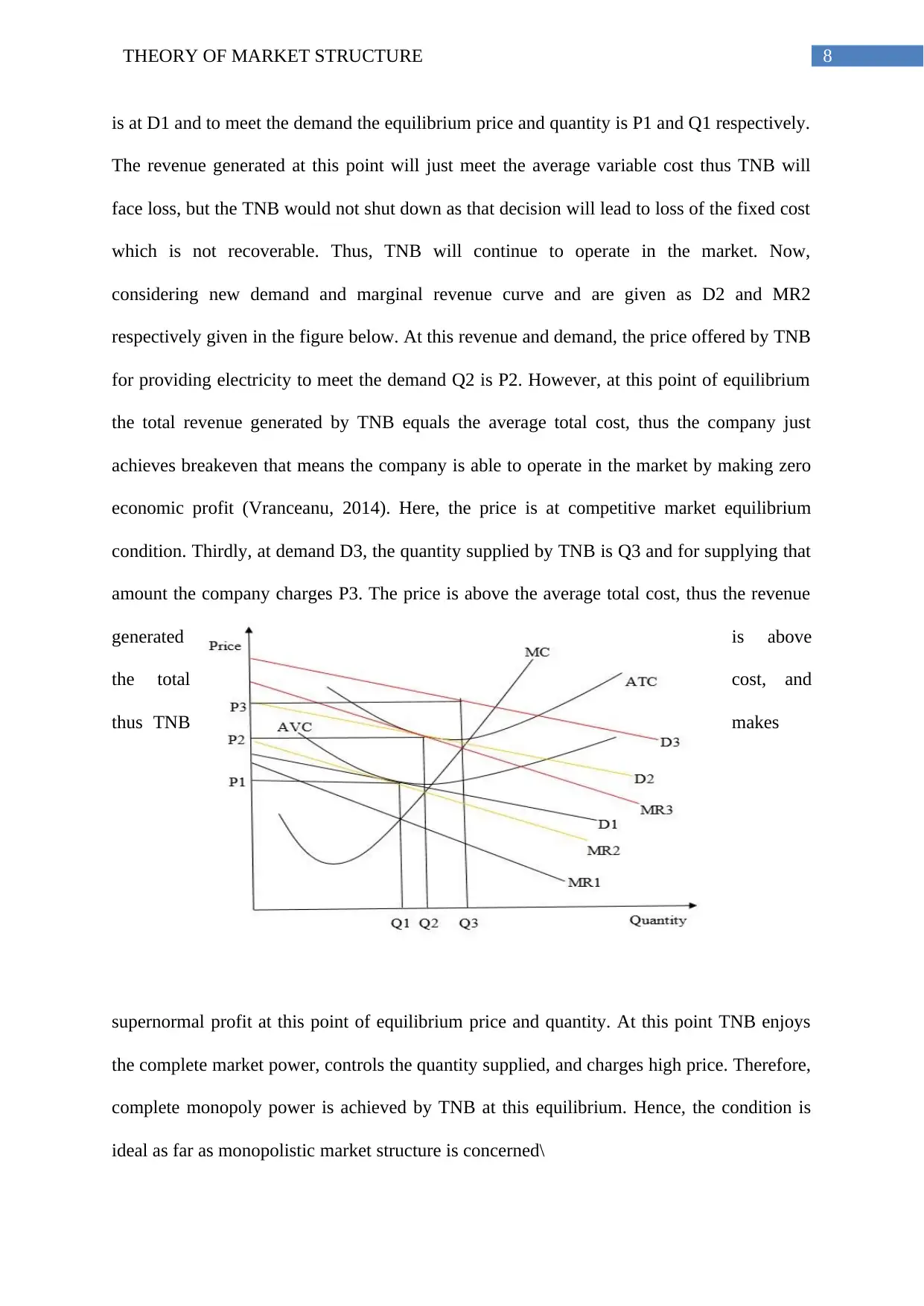
8THEORY OF MARKET STRUCTURE
is at D1 and to meet the demand the equilibrium price and quantity is P1 and Q1 respectively.
The revenue generated at this point will just meet the average variable cost thus TNB will
face loss, but the TNB would not shut down as that decision will lead to loss of the fixed cost
which is not recoverable. Thus, TNB will continue to operate in the market. Now,
considering new demand and marginal revenue curve and are given as D2 and MR2
respectively given in the figure below. At this revenue and demand, the price offered by TNB
for providing electricity to meet the demand Q2 is P2. However, at this point of equilibrium
the total revenue generated by TNB equals the average total cost, thus the company just
achieves breakeven that means the company is able to operate in the market by making zero
economic profit (Vranceanu, 2014). Here, the price is at competitive market equilibrium
condition. Thirdly, at demand D3, the quantity supplied by TNB is Q3 and for supplying that
amount the company charges P3. The price is above the average total cost, thus the revenue
generated is above
the total cost, and
thus TNB makes
supernormal profit at this point of equilibrium price and quantity. At this point TNB enjoys
the complete market power, controls the quantity supplied, and charges high price. Therefore,
complete monopoly power is achieved by TNB at this equilibrium. Hence, the condition is
ideal as far as monopolistic market structure is concerned\
is at D1 and to meet the demand the equilibrium price and quantity is P1 and Q1 respectively.
The revenue generated at this point will just meet the average variable cost thus TNB will
face loss, but the TNB would not shut down as that decision will lead to loss of the fixed cost
which is not recoverable. Thus, TNB will continue to operate in the market. Now,
considering new demand and marginal revenue curve and are given as D2 and MR2
respectively given in the figure below. At this revenue and demand, the price offered by TNB
for providing electricity to meet the demand Q2 is P2. However, at this point of equilibrium
the total revenue generated by TNB equals the average total cost, thus the company just
achieves breakeven that means the company is able to operate in the market by making zero
economic profit (Vranceanu, 2014). Here, the price is at competitive market equilibrium
condition. Thirdly, at demand D3, the quantity supplied by TNB is Q3 and for supplying that
amount the company charges P3. The price is above the average total cost, thus the revenue
generated is above
the total cost, and
thus TNB makes
supernormal profit at this point of equilibrium price and quantity. At this point TNB enjoys
the complete market power, controls the quantity supplied, and charges high price. Therefore,
complete monopoly power is achieved by TNB at this equilibrium. Hence, the condition is
ideal as far as monopolistic market structure is concerned\
⊘ This is a preview!⊘
Do you want full access?
Subscribe today to unlock all pages.

Trusted by 1+ million students worldwide
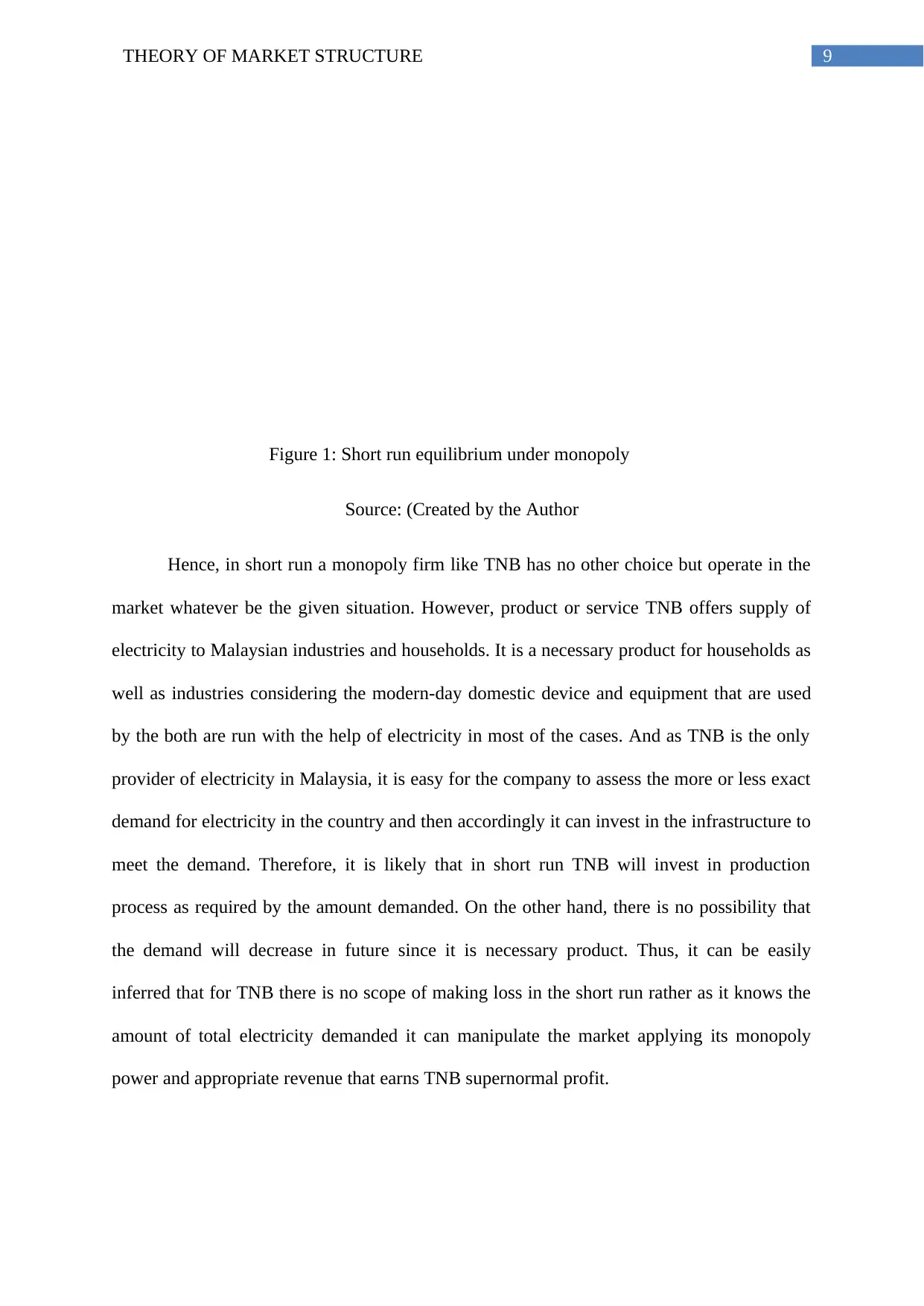
9THEORY OF MARKET STRUCTURE
Figure 1: Short run equilibrium under monopoly
Source: (Created by the Author
Hence, in short run a monopoly firm like TNB has no other choice but operate in the
market whatever be the given situation. However, product or service TNB offers supply of
electricity to Malaysian industries and households. It is a necessary product for households as
well as industries considering the modern-day domestic device and equipment that are used
by the both are run with the help of electricity in most of the cases. And as TNB is the only
provider of electricity in Malaysia, it is easy for the company to assess the more or less exact
demand for electricity in the country and then accordingly it can invest in the infrastructure to
meet the demand. Therefore, it is likely that in short run TNB will invest in production
process as required by the amount demanded. On the other hand, there is no possibility that
the demand will decrease in future since it is necessary product. Thus, it can be easily
inferred that for TNB there is no scope of making loss in the short run rather as it knows the
amount of total electricity demanded it can manipulate the market applying its monopoly
power and appropriate revenue that earns TNB supernormal profit.
Figure 1: Short run equilibrium under monopoly
Source: (Created by the Author
Hence, in short run a monopoly firm like TNB has no other choice but operate in the
market whatever be the given situation. However, product or service TNB offers supply of
electricity to Malaysian industries and households. It is a necessary product for households as
well as industries considering the modern-day domestic device and equipment that are used
by the both are run with the help of electricity in most of the cases. And as TNB is the only
provider of electricity in Malaysia, it is easy for the company to assess the more or less exact
demand for electricity in the country and then accordingly it can invest in the infrastructure to
meet the demand. Therefore, it is likely that in short run TNB will invest in production
process as required by the amount demanded. On the other hand, there is no possibility that
the demand will decrease in future since it is necessary product. Thus, it can be easily
inferred that for TNB there is no scope of making loss in the short run rather as it knows the
amount of total electricity demanded it can manipulate the market applying its monopoly
power and appropriate revenue that earns TNB supernormal profit.
Paraphrase This Document
Need a fresh take? Get an instant paraphrase of this document with our AI Paraphraser
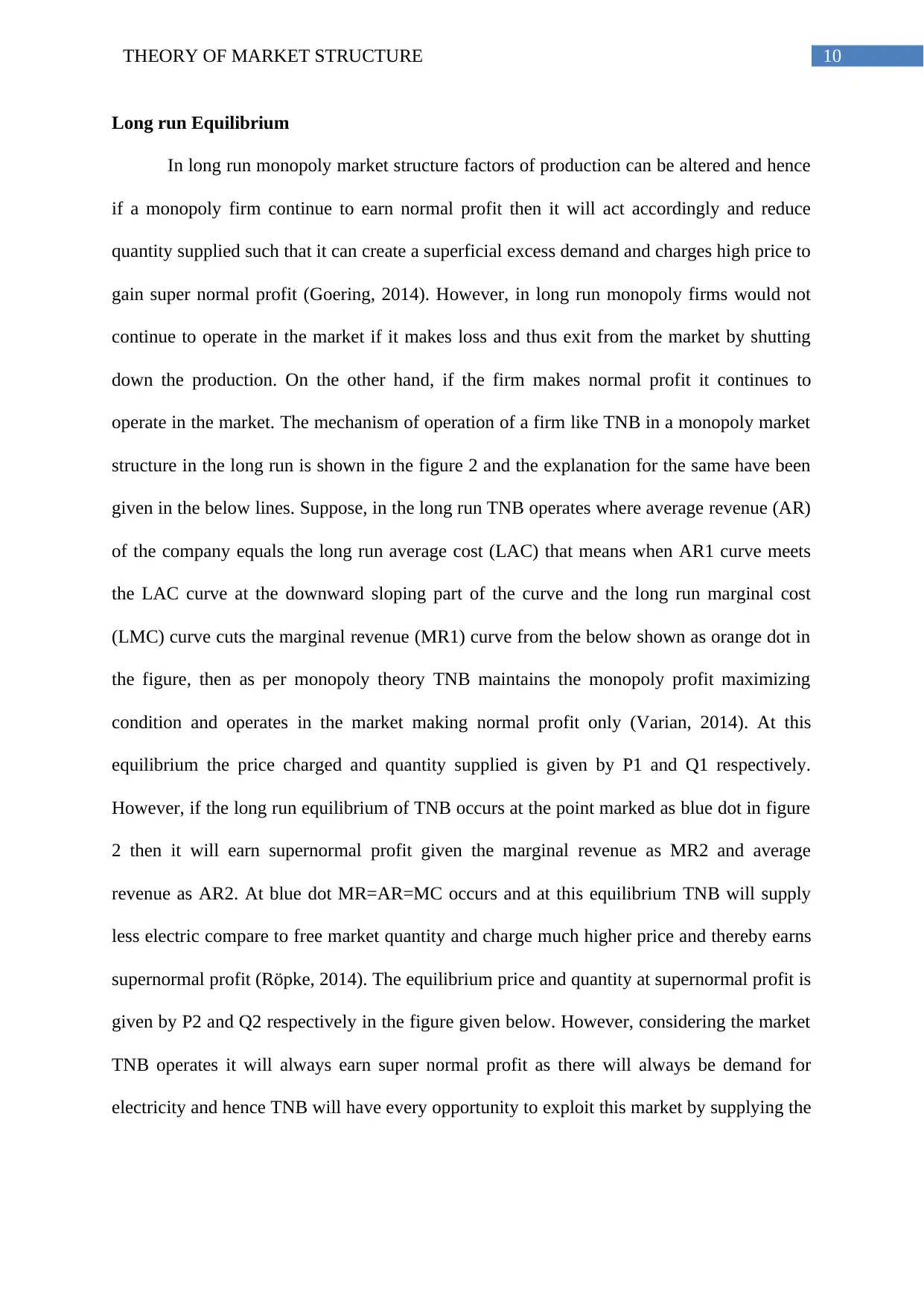
10THEORY OF MARKET STRUCTURE
Long run Equilibrium
In long run monopoly market structure factors of production can be altered and hence
if a monopoly firm continue to earn normal profit then it will act accordingly and reduce
quantity supplied such that it can create a superficial excess demand and charges high price to
gain super normal profit (Goering, 2014). However, in long run monopoly firms would not
continue to operate in the market if it makes loss and thus exit from the market by shutting
down the production. On the other hand, if the firm makes normal profit it continues to
operate in the market. The mechanism of operation of a firm like TNB in a monopoly market
structure in the long run is shown in the figure 2 and the explanation for the same have been
given in the below lines. Suppose, in the long run TNB operates where average revenue (AR)
of the company equals the long run average cost (LAC) that means when AR1 curve meets
the LAC curve at the downward sloping part of the curve and the long run marginal cost
(LMC) curve cuts the marginal revenue (MR1) curve from the below shown as orange dot in
the figure, then as per monopoly theory TNB maintains the monopoly profit maximizing
condition and operates in the market making normal profit only (Varian, 2014). At this
equilibrium the price charged and quantity supplied is given by P1 and Q1 respectively.
However, if the long run equilibrium of TNB occurs at the point marked as blue dot in figure
2 then it will earn supernormal profit given the marginal revenue as MR2 and average
revenue as AR2. At blue dot MR=AR=MC occurs and at this equilibrium TNB will supply
less electric compare to free market quantity and charge much higher price and thereby earns
supernormal profit (Röpke, 2014). The equilibrium price and quantity at supernormal profit is
given by P2 and Q2 respectively in the figure given below. However, considering the market
TNB operates it will always earn super normal profit as there will always be demand for
electricity and hence TNB will have every opportunity to exploit this market by supplying the
Long run Equilibrium
In long run monopoly market structure factors of production can be altered and hence
if a monopoly firm continue to earn normal profit then it will act accordingly and reduce
quantity supplied such that it can create a superficial excess demand and charges high price to
gain super normal profit (Goering, 2014). However, in long run monopoly firms would not
continue to operate in the market if it makes loss and thus exit from the market by shutting
down the production. On the other hand, if the firm makes normal profit it continues to
operate in the market. The mechanism of operation of a firm like TNB in a monopoly market
structure in the long run is shown in the figure 2 and the explanation for the same have been
given in the below lines. Suppose, in the long run TNB operates where average revenue (AR)
of the company equals the long run average cost (LAC) that means when AR1 curve meets
the LAC curve at the downward sloping part of the curve and the long run marginal cost
(LMC) curve cuts the marginal revenue (MR1) curve from the below shown as orange dot in
the figure, then as per monopoly theory TNB maintains the monopoly profit maximizing
condition and operates in the market making normal profit only (Varian, 2014). At this
equilibrium the price charged and quantity supplied is given by P1 and Q1 respectively.
However, if the long run equilibrium of TNB occurs at the point marked as blue dot in figure
2 then it will earn supernormal profit given the marginal revenue as MR2 and average
revenue as AR2. At blue dot MR=AR=MC occurs and at this equilibrium TNB will supply
less electric compare to free market quantity and charge much higher price and thereby earns
supernormal profit (Röpke, 2014). The equilibrium price and quantity at supernormal profit is
given by P2 and Q2 respectively in the figure given below. However, considering the market
TNB operates it will always earn super normal profit as there will always be demand for
electricity and hence TNB will have every opportunity to exploit this market by supplying the
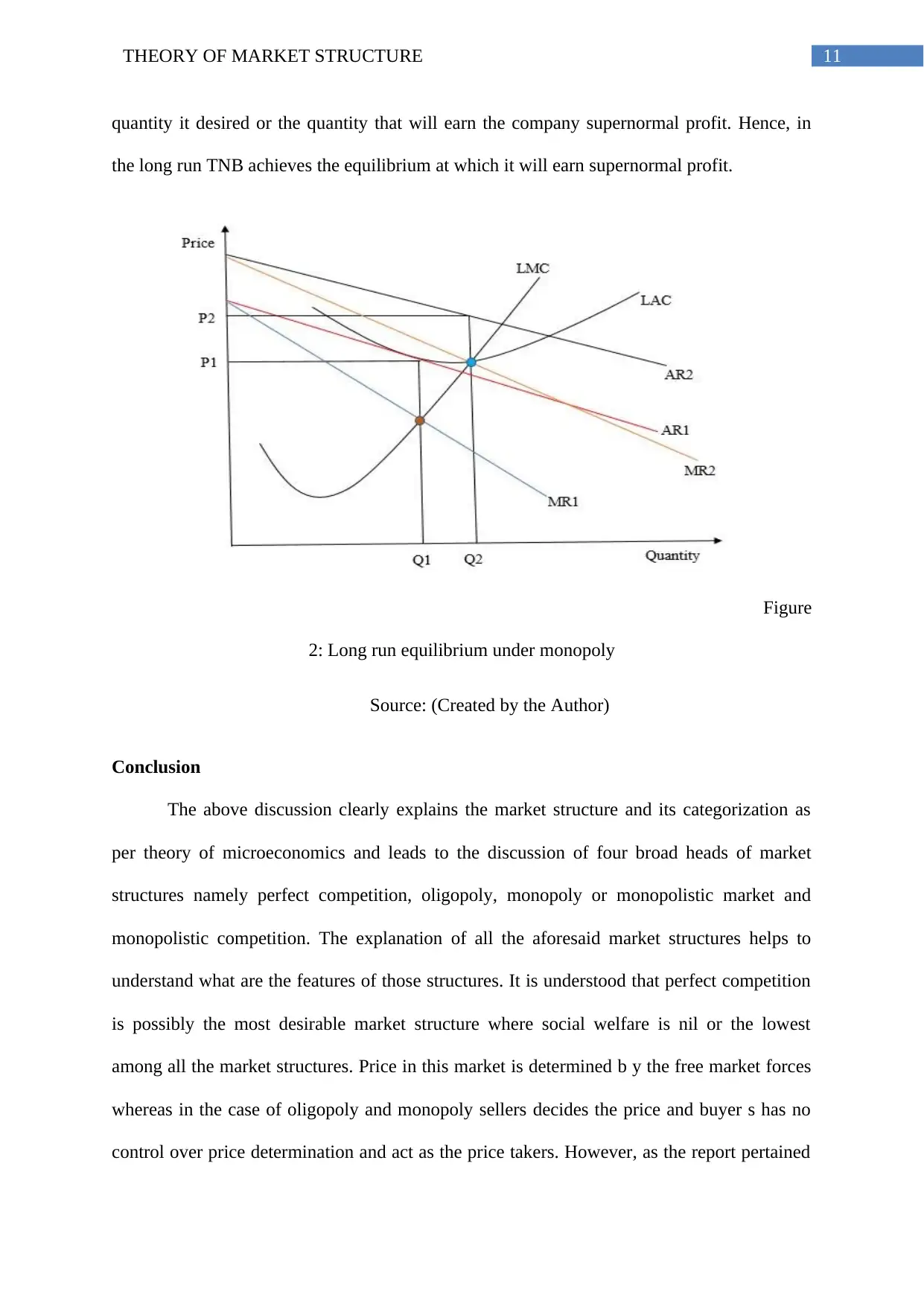
11THEORY OF MARKET STRUCTURE
quantity it desired or the quantity that will earn the company supernormal profit. Hence, in
the long run TNB achieves the equilibrium at which it will earn supernormal profit.
Figure
2: Long run equilibrium under monopoly
Source: (Created by the Author)
Conclusion
The above discussion clearly explains the market structure and its categorization as
per theory of microeconomics and leads to the discussion of four broad heads of market
structures namely perfect competition, oligopoly, monopoly or monopolistic market and
monopolistic competition. The explanation of all the aforesaid market structures helps to
understand what are the features of those structures. It is understood that perfect competition
is possibly the most desirable market structure where social welfare is nil or the lowest
among all the market structures. Price in this market is determined b y the free market forces
whereas in the case of oligopoly and monopoly sellers decides the price and buyer s has no
control over price determination and act as the price takers. However, as the report pertained
quantity it desired or the quantity that will earn the company supernormal profit. Hence, in
the long run TNB achieves the equilibrium at which it will earn supernormal profit.
Figure
2: Long run equilibrium under monopoly
Source: (Created by the Author)
Conclusion
The above discussion clearly explains the market structure and its categorization as
per theory of microeconomics and leads to the discussion of four broad heads of market
structures namely perfect competition, oligopoly, monopoly or monopolistic market and
monopolistic competition. The explanation of all the aforesaid market structures helps to
understand what are the features of those structures. It is understood that perfect competition
is possibly the most desirable market structure where social welfare is nil or the lowest
among all the market structures. Price in this market is determined b y the free market forces
whereas in the case of oligopoly and monopoly sellers decides the price and buyer s has no
control over price determination and act as the price takers. However, as the report pertained
⊘ This is a preview!⊘
Do you want full access?
Subscribe today to unlock all pages.

Trusted by 1+ million students worldwide
1 out of 15
Related Documents
Your All-in-One AI-Powered Toolkit for Academic Success.
+13062052269
info@desklib.com
Available 24*7 on WhatsApp / Email
![[object Object]](/_next/static/media/star-bottom.7253800d.svg)
Unlock your academic potential
Copyright © 2020–2025 A2Z Services. All Rights Reserved. Developed and managed by ZUCOL.




